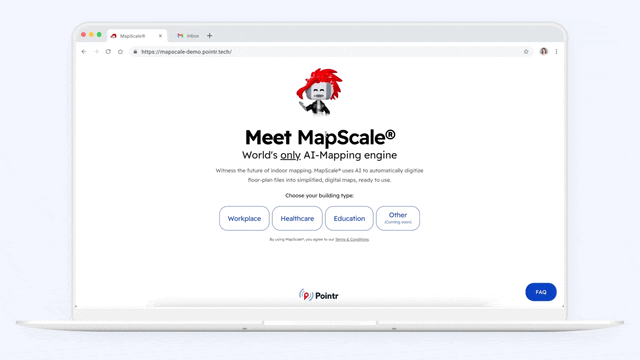An epic leap for indoor mapping
Rapid speed & less expensive
With MapScale®, there's no time-consuming delays or expensive surveys - it can get to work straight away:
-
Generate digital maps in minutes, not weeks: the manual mapping process has cost countless companies huge amounts of time. MapScale® is here to solve that problem.
-
No physical site visits or assessments required: MapScale® works purely from the mapping files that you provide, eliminating the need for in-person surveys
100% automated, AI-built maps
MapScale® automates your digital maps' digitization process, accelerating your mapping product process with:
-
Auto room/furniture identification: MapScale® automatically identifies rooms, furniture, and building outlines via machine learning modules. It can extract floor plan data such as images, annotation of the room and furniture, etc., and it improves with every map digitized.
-
Scheduled auto-update via API: MapScale® automatically retrieves your raw CAD files from a repository (on schedule or upon file changes) and converts them into interactive, beautifully designed digital indoor maps.
Easy, instant map management
We wanted to empower MapScale® users to not only save time and money on indoor mapping, but to control their maps the way they need to.
-
Pointr Cloud is a user-friendly map CMS, enabling you to manually adjust map details, and add, edit, or remove map points of interest
-
Open for integration, allowing you to source 3rd party data directly via Pointr Cloud API.
Auto-routing enables wayfinding
Pointr's smart auto-routing enables wayfinding the moment MapScale® converts your floor plans into interactive digital maps, transforming your location into an intuitive smart building in seconds! Pointr auto-routing supports:
-
Automatic path generation to guide users through locations via automatically-identified paths
-
User-friendly, turn-by-turn directions to help users navigate complex layouts, with re-routing for occasions when a user goes off path
Flexible API, broad file support
MapScale® API can be called anytime and quickly transfer map outputs into Pointr Cloud or your own mapping platforms
-
Update map content or integrate map data from 3rd party sources into Pointr Maps® (e.g., occupancy data, asset locations) via Pointr's SDKs.
-
Built on the GeoJSON open standard, and MapScale® accepts DWG, DXF, and vector PDFs.

Multi-modal MapScale® is here
MapScale® is the only solution that scales to enterprise needs using AI mapping
7 billion
Square feet of space mapped
10 million
Square feet mapped per week

How was MapScale® born?
Success Stories
AI-powered maps at The Home Depot
- Creating and maintaining thousands of store maps automatically
- Smart auto-routing enables shoppers to navigate
- AI-built maps
2300
Stores
500
million
Square feet mapped
Success Stories
Solving one of the US's largest retailers' mapping headache
- The retailer was manually creating and updating maps by hand in image editing software
- Process took several months per cycle
- Using MapScale®, the retailer was able to update every store map on a daily cycle
2000
Stores
15
Minutes
to update maps
MapScale® FAQ
How does MapScale® work?
Simply put, MapScale® is capable of taking basic, 2D architectural files (most commonly in the CAD format) and, through our propriety AI model and patented indoor mapping technology, transforming those files into fully-fledged, interactive 3D maps, complete with points of interest and other labels, ready for use within an app, in a kiosk, via browser or through Pointr Express®.
How does MapScale® use AI?
MapScale® leverages AI in two core ways:
-
When the CAD file is first ingested, we use AI, trained upon the thousands of maps that we've created over our years as a the market-leader in indoor mapping, to figure out what architectural features equal what map features. In its most basic form, this means translating basic features to the map - such as four walls and a door meaning a room. However, MapScale®'s AI has long since surpassed this sort of basic functionality: it can now, for example, differentiate between numerous different room types, interpret open areas within an indoor map, and identify important building features such as stairwells and elevators, as well as determining features that are present on the CAD file but that are unnecessary for inclusion on the produced map
-
Once the map itself has been created, MapScale®'s Large Language Model (LLM) takes over in order to parse both the text data from the CAD file and the map itself to interpret, contextualize, and categorize different rooms, areas, and points of interest. It's at this stage where MapScale® also uses LLM data to help it work out the most likely map features based on the type of building being mapped - for example, it can look at two nearly identical rooms on two separate maps and determine one is likely to be a waiting room as the map it's working on is of a healthcare facility, and the other is a meeting room as it's part of a workplace
And of course, one of the key benefits of using AI and LLMs in this way is that the more they're used and corrected by human oversight, the better and more accurate they become. MapScale® has mapped billions of square feet already, and the more CAD files it ingests and the more maps it produces, the richer this virtuous cycle becomes.
For further details on AI mapping and how MapScale® leverages AI, check out this post.
Why use AI for indoor map generation?
The idea for MapScale® came about when a major US retailer contacted us explaining that their existing solution for providing maps for their thousands of stores was manually creating and updating them, one by one, using image editing software. This process was immensely time consuming and, due to the limited resources of the team working on the maps, it could take weeks or even months for an outdated map to be reviewed and updated, at which point that store would fall to the back of the queue again and the map would quickly once again be out of date.
We needed a way to address the needs of this client, as well as many other enterprise-size companies, who generally require a solution to be scalable to their needs to be considered viable. This is where the idea for MapScale® came from; finding a way to rapidly, consistently, and accurately transform the common data sources that most businesses had - such as CAD files - and turning them into maps.
Using AI simply enables us to leverage the vast amount of information we have accrued over years as the market-leaders of indoor maps and enhance our process, by taking work (such as building the map from the original file, then tagging individual room types and building features) that previously would have needed a considerable amount of human time and automating it.
Does MapScale® make use of any human intervention?
Though MapScale® can now accurately detect map features with a consistency of 95%, there are still edge cases we need to be mindful of, such as if MapScale® works on a CAD file with map features it's never seen before, or on a type of building that it's not had the opportunity to work on regularly before (as it has with workplaces, healthcare facilities, and more).
For this reason, MapScale® makes use of a traffic light system whenever a map is updated via a new CAD file. This system works to detect the degree of changes between the old version of the map and the new one, and alerts the user if a significant amount of the map has changed between the two versions. This guards against instances such as the user accidentally uploading the wrong CAD file to replace a certain map.
MapScale® can also only work with the data it receives, even though it can often fill in the gaps in this data using AI. It's not unusual for MapScale® to create an almost-finished a map which just then requires some small human touches to finish things off - for example, adding rich details to some of the map's points of interest (like adding logos and opening hours on the listing for a restaurant in a shopping mall). In cases such as these, even when a new file is uploaded to MapScale® to update the map, the system remembers the human additions to the old map and retains them.
How much faster is AI map generation compared to human-created maps?
No two maps are the same, meaning it's impossible to put an exact number on the amount of time saved by using MapScale® compared to a human-created map. However, there's no question that when it comes to scale - having to update hundreds of maps simultaneously, for example - there's simply no comparison. MapScale® is capable of updating hundreds of maps in a matter of minutes, something it would take a human potentially days of work to complete.
How does MapScale® compare to other AI-based tools?
There's no doubting that MapScale® is capable of feats of mapping speed that human-led manually mapping simply isn't.
But how does it stack up against other AI-based tools? We believe that MapScale® is a one-of-a-kind tool with no direct competitors, so we can't compare it to another system exactly. However, by looking at other LLMs such as ChatGPT, we've been able to compare its ability to classify and identify mapping features. These results are published in our AI mapping benchmark.
Webinar
Watch the MapScale® webinar
Watch our recent webinar to explore the revolutionary platform that enables 100,000x faster map production.
Guide
The Ultimate Guide to Indoor Mapping
All you need to know about indoor mapping, from the basics through to commercial considerations, use cases, and more.
Video
How MapScale® works
Join Pointr CEO Ege Akpinar for an in-depth walkthrough of MapScale® in action.





